The Bulgarian is one of the most demanded tools in view of the universality. She can cut metal, stone, tile or concrete. With other discs, it turns out good cleaning of the weld and give the desired shape to metal surfaces. Special tips help remove old paint and rust, while other circles polish wood or steel to a perfect condition. Such widespread use allows you to actively use this tool in almost all plants dealing with metal or wood, as well as in private needs and small workshops. To choose the right grinder, it is necessary to understand its capabilities, depending on certain parameters. The key criteria for this device and their suitability for various activities are described below. After reading this information, it will turn out to buy a suitable tool that will be convenient for the implementation of the tasks and will last for a long time.
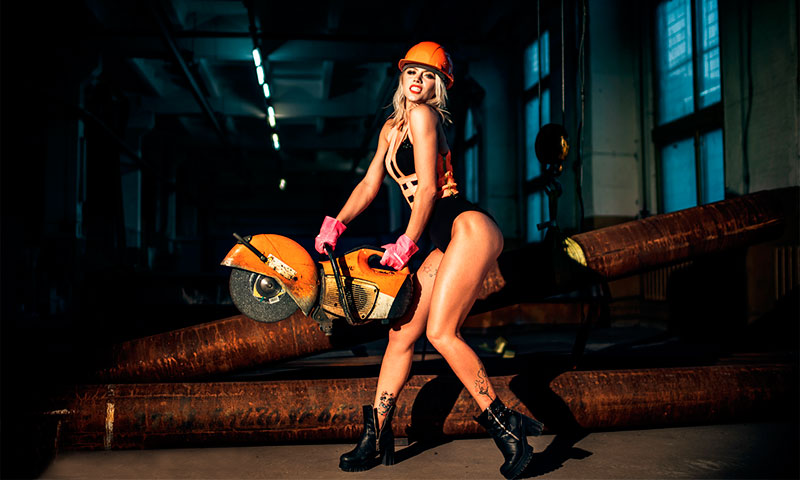
Content:
The best manufacturers of Bulgarians - which company to choose
The construction market is filled with a variety of products with cutting and stripping functions, but if you understand all the features of laziness, you can buy the products of any company from this list:
- Bosch;
- Metabo;
- Elitech;
- Hitachi;
- Makita.
Those who wish to see the real pros and cons of specific models will be useful to read. ranking of the best Bulgarians. Well, for a detailed analysis of all parameters and an independent choice of a model, the criteria are provided below.
The principle of operation and device grinders

The Bulgarian is a construction tool with a large number of functions. They are also called angle grinders (angle grinders). The main action is to rotate the disk at high speed, making it possible to process or cut various parts.
By changing nozzles (discs), the tool is able to cut metal sheets and rods. If you install the disk on concrete, they will be able to cut the tiles and cut the grooves in the wall. Wire nozzles allow you to remove rust and paint from car bodies and other parts. Flap discs grind wood and steel to a high degree of smoothness. Wiping abrasive circles align the shape of the welds and make chamfers.
The widespread use of this tool has been reflected in the construction and repair work in the apartment, the replacement of plumbing, the production of metal structures and woodworking. Often the sound of the grinder can be heard at the service station or at the municipal services for the repair of heating networks. No private workshop can do without it.
To maintain the work, the designers carefully thought out the device of the grinder, which consists of:
1. power unit;
2. brushes for voltage transfer;
3. central shaft with an anchor;
4. bearings;
5. two gears transmitting torque at a connection of 90 degrees (gear);
6. axles for dressing nozzles;
7. the fixing nut;
8. protective casing;
9. handles and start buttons.
To use the device, you must wear goggles or a mask, construction gloves and heavy clothing. The tool is taken with both hands, is brought to the place of cut and the start button is pressed.
Rotation at high speed allows the disk consisting of a tightly glued abrasive on the cord mesh to cut through the solid structure of the metal or scrape off its top layer. In the case of work with concrete and stone, a steel circle with teeth is used.
Abrasive discs are of various diameters and thicknesses, under the common dimensions of the Bulgarians, which determines the capabilities of the tool. In small circles, it is easy to make undercuts or cut openings of various geometries. Large disks quickly cut pipes or cut a sheet of metal.
If necessary, there is the possibility of placing small circles on large grinders, provided that the dimensions of the gearbox make it possible to reach the cutting part to the treated surface. Installing large circles on small grinders is not allowed.
Types of Bulgarians
Despite the general purpose and principle of operation, there are several basic types of Bulgarians, which differ in the internal structure or power source. It allows to use them in various working conditions.
Network grinders

The most common type of Bulgarians working on the voltage of 220 V. Most often used in factories for the manufacture of doors, gates, safes, racks, stairs and other metal structures.
There are many models for the installation of various disk diameters. Most suitable for work in a room or yard, where there is an opportunity to stretch the carrying. Often this type of tool is acquired for personal use at the cottage.
It is the network models used by builders for cutting bricks, tiles, replacing plumbing, laying wiring. Depending on the power there are household and professional Bulgarians.
Advantages:
- different body dimensions for different disc diameter;
- powerful and economical models;
- high rotation speed;
- affordable cost;
- low weight;
- a large number of nozzles;
- long service life.
Disadvantages:
- volatile;
- wire may interfere with movement in the workplace;
- when the voltage drops in the network do not work well.
Cordless grinders
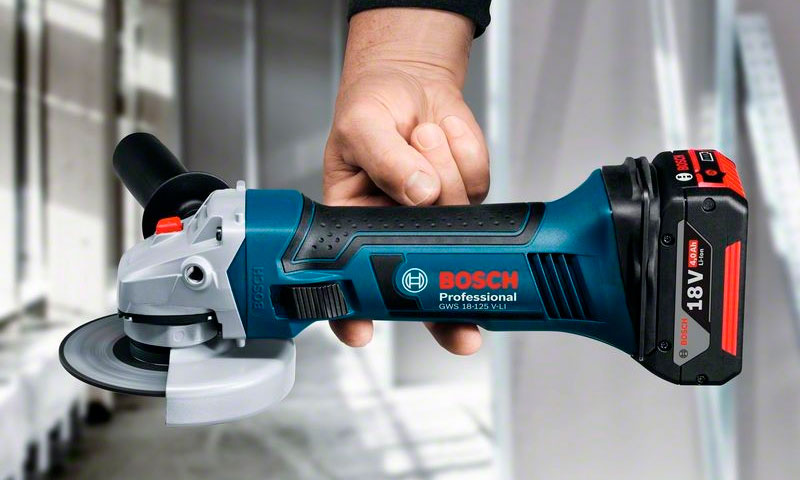
They have a similar structure with the network, but differ in a large compartment at the end of the handle, where the battery is attached. Most often produced in a small case, which serves as the main handle to hold. Completed with disks 125-150 mm.
Autonomy allows you to use them remotely from the power source: emergency opening of doors, installation of fences far in the field, work in a forest house without electricity.
As the battery 18 V are used Li-lon capacity. But this model will not work throughout the day and will require recharging, so it is suitable only for short tasks.
Advantages:
- have a large disc rotation speed;
- compact housing design;
- most models are sold with a case;
- small weight for convenient work;
- contain various protective functions;
- additional handle reduces vibration and helps to keep the tool smoother.
Disadvantages:
- battery life is limited by battery capacity;
- some models are sold without batteries, which requires an additional purchase;
- the ability to work only with small disks;
- high cost of goods.
Pneumatic grinders

Unlike all other types of pneumatic grinders do not have a motor or motor. High rotational speed is created by applying air pressure to the blades inside the body. They start the torsion of the axis with the disk.
To start work, a valve is used which opens the access of air to the internal channel. Thanks to this design, the pneumatic grinder is the easiest among the cutting tools and is suitable for long work throughout the day.
This type is most used in metalworking industries, where workers have to manipulate the device in the hands of 6-8 hours. For the operation of the device requires the availability of additional devices (compressor or air network).
Advantages:
- very light weight;
- no overheating due to the lack of a motor;
- can work continuously for 6-8 hours;
- cheap repair (replacement of bearings and valve);
- safe use at high humidity;
- high speed;
- the noise is only from cutting, the work itself is silent.
Disadvantages:
- high price;
- Requires additional equipment.
Petrol grinders
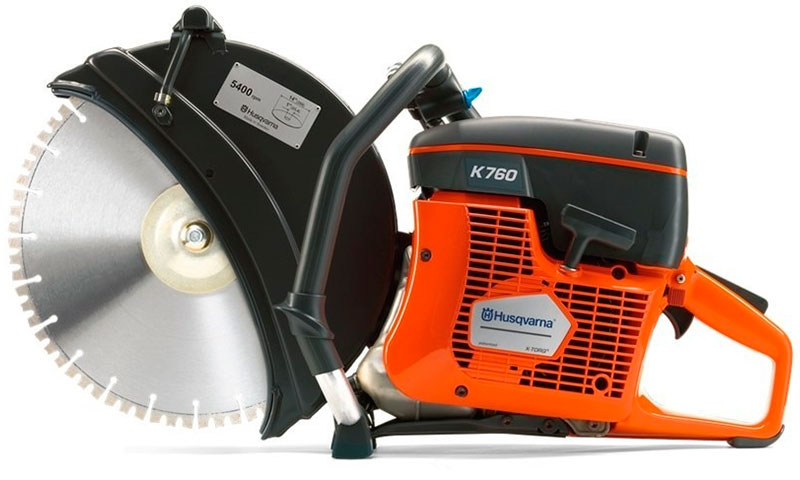
They have a large body due to the location of the internal combustion engine and fuel tank. To hold the device provides a large frame-handle and auxiliary handle. This type of tool is equipped with large diameter discs and is used for cutting concrete or iron in conditions where there is no electricity.
Most often, the scope of the use of gasoline bolts - this repair work on the pipelines or rail tracks. The device has increased noise due to the loud sound from the engine itself, which requires hearing protection.
Advantages:
- powerful models with large circles;
- fast cutting of large objects (pipes, profiles, concrete products);
- autonomy;
- the ability to work over a long period due to refueling;
- availability of stand for use as a cutting machine.
Disadvantages:
- additional costs for gasoline;
- loud work;
- interaction only with large diameter discs;
- required breaks for cooling the motor;
- Large dimensions are inconvenient for the tool to reach the cut area in hard-to-reach places.
Bulgarian selection options
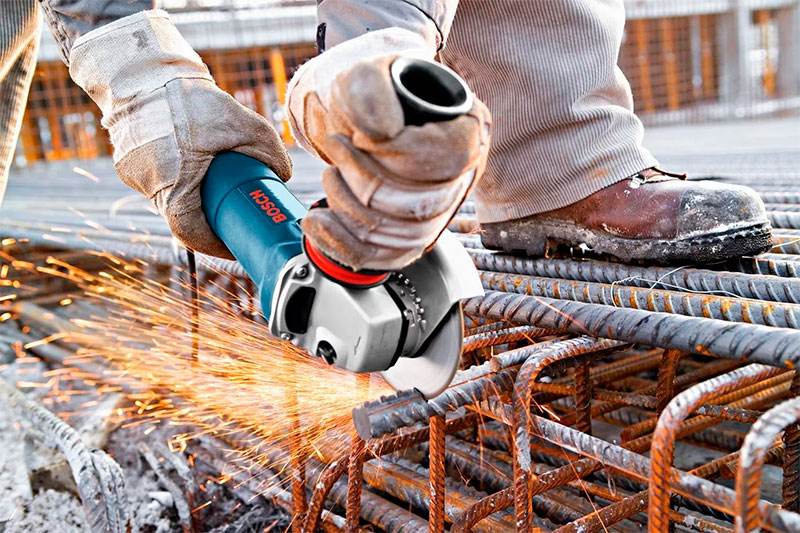
The Bulgarian is a serious tool acquired for many years and capable of significantly facilitating the performance of certain works. There are more than ten parameters for choosing this device, on which the sales rate and the quality of the finished product depend. Given these criteria, it will turn out to choose a Bulgarian for specific tasks.
Disc diameter
To work grinder sold a wide variety of discs with a diameter of from 115 to 400 mm. Small circles can be placed on large models, provided that the cutting part reaches the material being processed. Installing large disks on small devices is strictly prohibited.
Choosing a grinder it is worth thinking about how thick it will have to cut it:
1. If these are minor repairs on the doors, the manufacture of carts, safes, cutting holes in a sheet of metal, then a sufficiently small tool with the possibility of setting a disc is 115-150 mm.
2. To quickly cut the pipe into two inches will require a disk with a diameter of 180 mm, but it is suitable for a single cut.
3. In case of constant need to work with thick pipes, the circle will soon be erased and it will not be enough for one pass, which will require turning the part and the second cut, which, perhaps, will skew the line. Here it is better to acquire the maximum size for the electric version of 230 mm and a large grinder.
4. For very thick elements (rail, pipe of large diameter), petrol cutting machines with a circle diameter of 400 mm are well suited.
Power
According to the power capabilities, grinders are divided into household (0.5-0.9 kW) and professional (1-3.7 kW). Power allows you to quickly cut and not stop when immersed in dense material.
1. For a short work in the country enough tools with a rate of 0.5-0.7 kW.
2. To work in the shop with the metal model needed 0.8-1.2 kW.
3. For the construction of a useful model with the parameter 1.3-2.7 kW.
Speed
This is a significant factor affecting performance. The higher the spindle speed, the faster you can clean the surface from rust or cut through the part.
1. In a domestic environment, this indicator is unimportant and minimum values of 6000 rpm are suitable.
2. On production for the manufacture of doors and gates, models with a frequency of 7000-11000 rpm are needed.
3. At the service station, where the body often needs to be stripped before painting or welding, a Bulgarian with revolutions of 15,000 per minute is needed.
Weight
The weight of the grinder creates a load on the hands and back of the operator.
1. The lightest are pneumatic types of tools, the weight of which starts from 1.2 kg. Such models should be bought when working with a grinder for 4 hours every day.
2. If the device has to be ground and cut for 2-3 hours, then 3-4 kg parameters will do.
3. For the periodic cutting of pipes on the highway and fitting the edges, you can buy a heavy large model of 6-9 kg, which will quickly cope with the task.
Protective functions
A tool with protective functions will last longer and it will be safer for them to work.
Among the innovations that Bulgarians may have are the following:
1. Smooth start-up - allows you to slowly accelerate the motor at high speed and does not pull the body when you turn it on. The function will be especially useful for beginners or people with poor physical fitness, gunning heavy versions of Bulgarians. It is also practical for accurate guidance of the disk to the cutting line - you can take a comfortable position and set the circle to the beginning, and then turn on the device without a jerk.
2. Protection against accidental start-up - is responsible for blocking unauthorized rotation. This is achieved by a two-button trigger device, where only the drowning of both closes the contact and starts the device. The function is useful for working in cramped conditions (plumbing, car repairman), where accidental contact with a close tool is possible.
3. Rotational support under load - allows you to keep the rotational speed even under strong pressure. This protects the engine and prolongs its life. Such a function should be sought by those who work with solid materials of large thickness (concrete, brick, thick steel).
4. Adjustment of turns - gives the chance to establish rotation frequency depending on the performed work. This protects the motor and the product from overheating. The function is suitable for those who often perform diverse operations with a grinder (for grinding wood, the average speed, and for polishing metal high).
Convenience and shape pens
The main grip on large models is desirable with finger protection. It is convenient for work on stations, factories and workshops. So, cutting the necessary parts, you will not hit your hand and you will not release the tool. For small Bulgarians, it is important to expand at the end of the blocking slip from sweaty hands.
The auxiliary handle must have a mushroom shape to securely fix the device. If it can be twisted into 4 positions, then this will allow changing its attachment point depending on the type of work and will increase convenience.
Nut retainer
To replace a worn disc or to install another type of nozzle, you need to stop the spindle with a special clamp and unscrew the nut with a key.
1. If you need to change the nozzle 5-7 times, then it is quite possible to do the classical method of fixation.
2. If you often have to change the nozzles (cut, grinding, polishing, cleaning), then it is practical to buy a grinder with a fast-locking SDS nut. It rotates around the axis without a key and the disk is replaced in 5 seconds.
Working with concrete
All large grinders can be equipped with a steel disc with teeth, which will allow them to cut bricks and concrete. If this is necessary only periodically, then any model of the appropriate size will do. But for electricians who constantly strobe walls for laying wiring, a model with special winding protection is required.
A large amount of dust and small particles in the air can clog the contacts and interfere with the rotation of the armature, so the usual types of Bulgarians will quickly fail. A winding protection tool, on the contrary, will work for a long time in this aggressive environment.
Tank and battery capacity
In the petrol version, autonomous operation depends on the capacity of the fuel tank, the range of which is 0.7-1.5 liters. If there is not enough space in the working machine for additional fuel, then it is practical to buy a grinder with a maximum tank size of 1.5 liters. In the case of a spare canister, this parameter is not important.
Battery models have a capacity of 2-4 A / h. This allows the tool to develop high speed (up to 11000) and effectively cope with various tasks. In order to insert the lock into the metal door of the forest house without electricity, there will be enough batteries with 2 A / h, and in the mobile field crew on emergency opening of the locks, where the forthcoming amount of work is unknown, 3-4 A / h will be required.
Air pressure and speed
Pneumatic models operate at an acceptable speed due to a specific air supply, which can be from 6 to 6.5 atmospheres. Choosing such a grinder one should make sure of the capabilities of the compressor or the air line to provide this pressure.
Air velocity plays an important role in maintaining a high rotational speed of the cutting part of the tool. This parameter varies from 100 to 540 liters per minute. The larger the diameter of the disk, the higher should be the flow rate of the air flow.
1. For fine fitting of pipes and cutting of reinforcement, a speed of 100-150 l / min is sufficient,
2. 200 l / min is required for grinding weld seams.
3. For large volumes of stripping, powerful pneumatic grinders for 350-400 l / min are needed.
Which grinder to choose
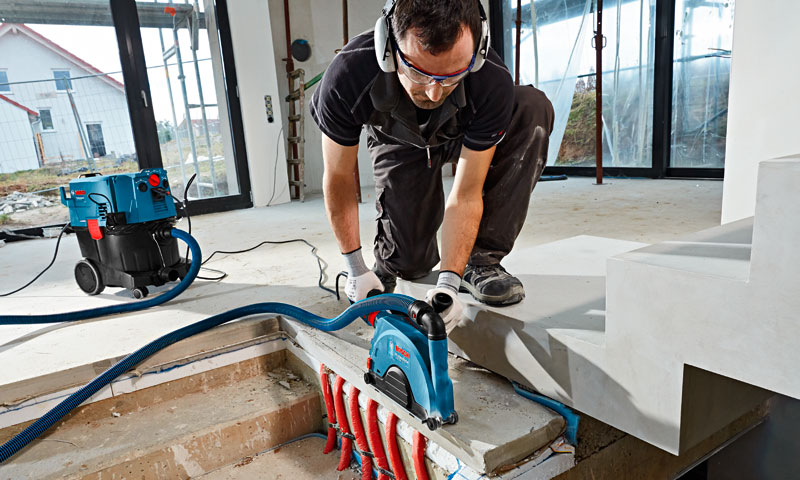
1. In order to carry out minor repairs of metal doors and emergency opening of locks, a battery model with a capacity of 3 A / h, a power of 0.6 kW and revolutions of 13,000-15,000 per minute is needed. The diameter of the disc is from 76 to 150 mm and weighing 1.5-2 kg.
2. For the classical production workshop for the production of metal structures or teams to eliminate leaks in heating and running water, a Bulgarian needs a net power of 1.5 kW, 230 mm discs, 7500 revolutions per minute and a weight of 4 kg. Use the soft start system. The same model is also needed at the construction site for shtenning walls, but then it will need a winding protection function.
3. A pneumatic model with a mass of 1.2 kg, discs of 150 mm and an air flow rate of 200 l / min will be suitable for the metalworking grinding enterprise.
4. For utilities to repair pipes or rail tracks, a model with a gasoline engine, weighing 8 kg, and discs of 400 mm is required. Useful will be the power of 3.6 kW and a 1.5 liter tank.
5. At the cottage you can buy a simple net grinder of 0.7 kW with 180 mm discs and 9000 revolutions per minute. Weight suitable up to 5 kg.
How much is the Bulgarian
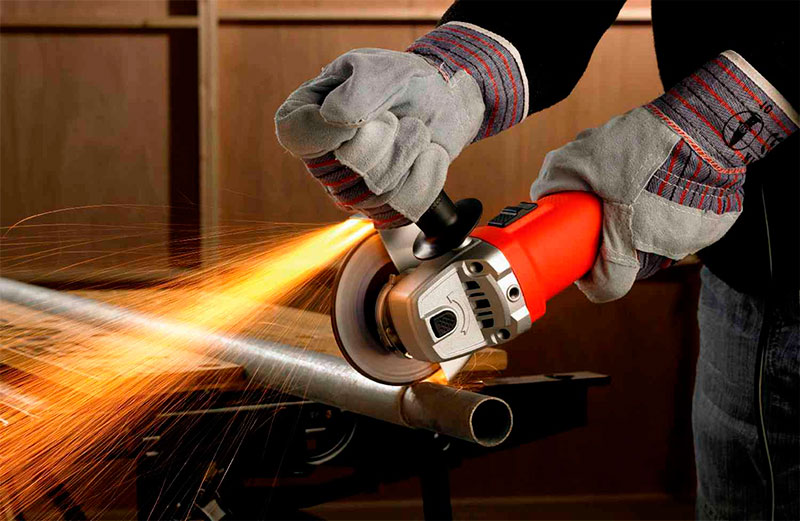
1. Bulgarian on batteries for repair work will cost 8000-22000 rubles.
2. For the production or construction of a network tool will cost 6000-20000 rubles.
3. Pneumatic models for the processing of metal structures are estimated at 8000-31000 rubles.
4. For public services petrol grinders will cost 22000-31000 rubles.
5. At the cottage you can buy a device for 2000-6000 rubles.
It will be interesting to friends too







